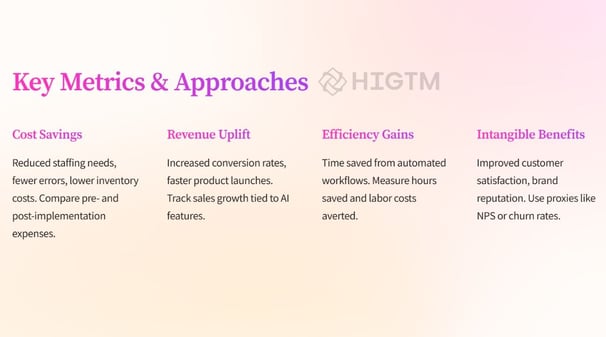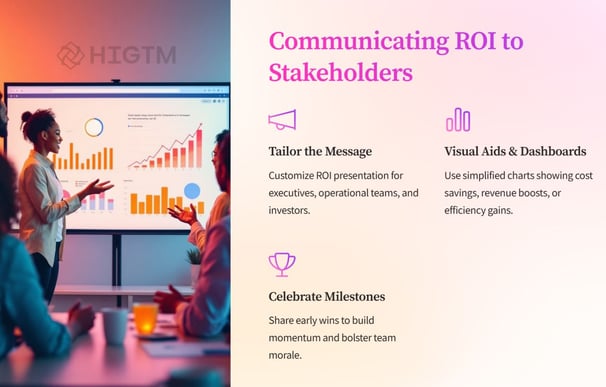12. ROI of AI Investments: Calculating and Communicating Returns for SMEs
What’s the return on investment (ROI)? Whether you’re automating tedious tasks, improving sales conversions, or powering advanced analytics, AI initiatives demand upfront resources—time, budget, and skilled personnel. Proving that these expenses translate to real, financial gains (or other meaningful benefits) is crucial for obtaining stakeholder support and ensuring long-term sustainability. This post provides a practical framework for SMEs to calculate and communicate the ROI of AI projects. We’ll start by exploring why ROI matters so much in AI contexts, then break down the key metrics and evaluation methods that enable accurate cost-benefit assessments. We’ll also discuss common pitfalls that hamper AI’s impact and outline a step-by-step guide for gauging returns effectively. Finally, we’ll cover best practices for presenting ROI findings to different audiences—from executives and operational teams to investors and clients—so you can maintain trust and momentum in your AI journey.
Q1: FOUNDATIONS OF AI IN SME MANAGEMENT - CHAPTER 1 (DAYS 1–31): CORE AI CONCEPTS & VALUE PROPOSITION
Gary Stoyanov PhD
1/12/20256 min read

1. Why ROI Matters in AI
Artificial Intelligence may spark excitement with its potential to transform entire industries, but enthusiasm alone can’t justify the allocation of limited SME resources. Understanding ROI in AI contexts provides clarity on which projects deliver meaningful value and aligns each initiative with your business strategy.
Resource Allocation
Limited Budgets and Staff: SMEs have finite budgets, so every dollar spent on AI must have a clear purpose—whether cutting overhead costs or boosting revenue streams.
Targeting High-Value Use Cases: By quantifying potential returns, leaders can prioritize AI projects with the greatest financial or strategic impact.
Confidence Building
Stakeholder Buy-In: A strong ROI projection can win over executives, team leads, and investors who might be skeptical about AI’s complexity or uncertain outcomes.
Operational Support: Concrete metrics quell anxieties around AI-induced change by showcasing tangible benefits, like reduced workload or new revenue.
Continuous Improvement
Iterative Refinement: Monitoring returns reveals areas where models or processes need tweaks, ensuring you optimize AI performance over time.
Scaling Insights: If the ROI data for one department or pilot is compelling, expanding those successes across the organization becomes easier.
In short, focusing on ROI in AI fosters disciplined decision-making, ensuring each project is grounded in real needs rather than hype or guesswork.
2. Key Metrics & Approaches
When calculating AI’s value, it’s essential to look beyond pure cost savings or revenue spikes. AI can enhance efficiency, employee morale, and the overall customer experience. Below are common metrics to consider, along with potential real-world scenarios in which SMEs benefit.
2.1 Cost Savings
Examples:
Reduced staffing needs for repetitive tasks
Fewer errors or returns in manufacturing
Lower inventory holding costs or shipping expenses
Measurable Outcome:
Compare pre- and post-implementation expenses: e.g., if manual data entry took 200 staff hours monthly, see how those hours drop post-AI adoption.
Scenario: A travel agency automates 60% of email inquiries through a chatbot, cutting hours spent on repetitive answers and lowering seasonal temp hires.
2.2 Revenue Uplift
Examples:
AI-driven recommendations increasing upsells
Faster product launches enabled by predictive analytics
Improved customer retention through better personalization
Measurable Outcome:
Track direct sales growth or new client acquisitions influenced by the AI feature. This could be done by comparing the sales performance of AI-driven vs. non-AI-driven product lines.
Scenario: An e-commerce SME that introduces an AI recommendation engine sees a 15% lift in average cart value over six months.
2.3 Efficiency Gains
Examples:
Automating workflow approvals reduces turnaround times
AI-based lead scoring shortens the sales cycle by prioritizing high-value prospects
NLP-based support ticket routing speeds issue resolution
Measurable Outcome:
Calculate time saved (hours or days) and labor costs averted. Also track improvements in throughput or response speed.
Scenario: A B2B firm deploys a lead scoring model that routes hot leads to senior sales reps first, slashing conversion time by 20%.
2.4 Intangible Benefits
Examples:
Boost in employee morale (fewer tedious tasks, more strategic involvement)
Customer satisfaction improvements from quicker service
Strengthened brand reputation for innovation
Measurable Outcome:
Use proxies such as Net Promoter Score (NPS), social media sentiment, churn rates, or staff retention trends. While intangible, these often correlate with long-term financial performance.
Scenario: A healthcare SME sees staff morale rise as routine data entry is automated, freeing personnel to focus on patient care—leading to higher retention and better patient reviews.
3. Common AI Investment Pitfalls
Despite the potential rewards, SMEs frequently stumble on the ROI path. Recognizing these pitfalls can save time, money, and frustration:
Overlooking Data Quality
Risk: Subpar data leads to flawed models; ROI plummets if the outputs misguide decisions.
Avoidance: Start with data cleanup or narrow the problem scope to well-defined datasets.
Unclear Objectives
Risk: Vague goals make it impossible to quantify success. Projects lack direction, complicating ROI measurement.
Avoidance: Tie AI initiatives to specific business objectives, e.g., “lower fulfillment costs by 15%.”
Underestimating Change Management
Risk: Teams resist or poorly adopt AI tools, undermining potential gains.
Avoidance: Engage employees early, clearly communicate benefits, and offer adequate training.
Neglecting Scalability
Risk: Projects remain in perpetual pilot mode or fail under heavier data loads.
Avoidance: Build a roadmap for incremental scaling—plan for future expansions in data and user capacity.
Pro Tip: By aligning data, objectives, and stakeholder engagement from day one, you reduce the chance of a “technology push” that never meets genuine business needs.
4. Practical Steps to Calculate ROI
While there’s no universal formula that fits all projects, a disciplined approach ensures your calculations remain transparent and credible. Here’s a step-by-step guide tailored for SMEs.
4.1 Define the Baseline
Why: You can’t measure improvement without a benchmark.
How: Gather pre-AI metrics—like monthly revenue, average handling time, current error rates, or customer churn. This baseline quantifies what your performance looks like today.
Example: A logistics SME records an average of 12 shipping errors per week before adopting an AI-driven routing tool.
4.2 Estimate Project Costs
Why: Comprehensive cost assessments prevent surprise budget overruns.
How: Include software fees, cloud expenses, staff time for training, possible consulting costs, and any hardware upgrades. Don’t forget ongoing maintenance or model retraining.
Example: Over a 6-month period, you forecast $2,000 on a cloud AI subscription, $5,000 worth of staff time (training/implementation), and $1,000 for an optional consultant review.
4.3 Identify Measurable Gains
Why: Clarify which metrics your AI solution will directly affect—like reducing waste or boosting sales.
How: Brainstorm both tangible (cost savings, new revenue) and intangible (employee satisfaction, brand lift) outcomes. Assign quantifiable measures where possible.
Example: Implementing an AI-based invoice processing system might reduce manual labor from 40 hours per month to 10, saving $3,000 monthly in staffing costs.
4.4 Apply an ROI Formula
A basic ROI formula is:
ROI (%) = (Net Gain from AI / Total AI Investment) × 100
Where:
Net Gain = (Financial Benefits) − (Project Costs)
Financial Benefits: Gains from increased revenue, cost savings, or new client acquisitions.
Project Costs: Direct expenditures for AI tools, implementation, support, plus staff time.
Example:
If your net gain (savings + new profits) totals $30,000 and total project costs are $15,000, your ROI is (30,000−15,000) / 15,000 × 100 ≈ 100%
4.5 Validate & Refine
Why: AI projects can over-promise or deliver unexpected results, so checking your post-implementation data clarifies if the initial ROI estimates hold.
How: After a suitable period (e.g., 3–6 months), compare predicted vs. actual outcomes. Adjust model parameters if performance lags or incorporate more data to improve accuracy.
Example: A machine learning model forecasting demand might overshoot certain seasonal events. Incorporating real-time customer data or weather inputs may fix the discrepancy, refining your final ROI figure.
5. Communicating ROI to Stakeholders
A robust ROI calculation is only half the battle. To sustain AI initiatives and broaden adoption, it’s critical to present these figures compellingly to diverse audiences—executives, operational teams, and investors.
5.1 Tailor the Message
Executives: Emphasize bottom-line impact—how AI aligns with strategic goals and drives profitability or competitive edge.
Operational Teams: Show how AI solutions free them from tedious tasks and improve daily workflows—highlight time savings, error reduction, or skill enhancement opportunities.
Investors: Stress scalability—could your successful AI pilot expand market share or open new product lines? Mention possible future returns and synergy with other business units.
Example: If you saved $50,000 in inventory mismanagement, highlight that figure to the CFO and how it could finance further AI expansions to the board. For frontline staff, underscore less frustration from stockouts and simpler reorder processes.
5.2 Use Visual Aids & Dashboards
Why: Charts, graphs, or dynamic dashboards quickly illustrate cost savings over time, revenue boosts, or efficiency gains.
How: Depict monthly improvements side-by-side with historical performance. A single visual can communicate complex data points in an easy-to-digest format.
5.3 Celebrate Milestones
Why: AI initiatives can feel technical; celebrating a 10% operating cost reduction or a 12-hour cut in average handling time demonstrates real progress and builds morale.
How: Publicly acknowledge teams who contributed. This fosters cultural openness to future AI projects, as people see concrete wins, not just a new technology overhead.
Gauging AI's return on investment (ROI) is a strategic imperative. By identifying the right metrics—whether cost savings, revenue gains, or efficiency improvements—SMEs can definitively show how AI investments pay off. Avoiding pitfalls like unclear goals, poor data quality, or insufficient change management, further boosts success rates. By applying a step-by-step approach—defining a baseline, estimating costs, identifying measurable gains, and applying a straightforward ROI formula—leaders gain a transparent, credible method to evaluate AI’s bottom-line impact.
Communicating these returns effectively closes the loop, ensuring executives, employees, and investors all understand AI’s worth. From personalized presentations to visually compelling dashboards and milestone celebrations, a well-structured communication strategy keeps momentum high and fosters trust in AI as an ongoing driver of organizational value.
At HIGTM, we champion a results-driven AI approach—helping SMEs plan, deploy, and measure their initiatives so they can confidently scale up. By mastering ROI analysis, you transform AI from a speculative cost center to a verifiable catalyst for growth, efficiency, and competitive advantage in a rapidly evolving business landscape.




Turn AI into ROI — Win Faster with HIGTM.
Consult with us to discuss how to manage and grow your business operations with AI.
© 2025 HIGTM. All rights reserved.
